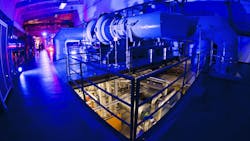DLR and Rolls-Royce Deutschland advance two-stage, high-pressure turbine tech
GOTTINGEN, Germany - The German Aerospace Center (Deutsches Zentrum für Luft- und Raumfahrt; DLR) has made significant progress in developing turbines for efficient and climate-compatible aircraft engines in collaboration with Rolls-Royce Deutschland. Researchers have deployed a trick carried over from many modern aircraft wings: attaching 'winglets' to the tips of the turbine blades to increase engine efficiency. Winglets and other technologies are already being used in the latest Rolls-Royce engines from the Pearl range and have significantly reduced fuel consumption, DLR reports. Continue reading original article.
The Military & Aerospace Electronics take:
15 July 2024 - Researchers at the DLR Institute of Propulsion Technology in Göttingen, in collaboration with Rolls-Royce Deutschland, investigated a new two-stage high-pressure turbine. Utilizing the Next-Generation Turbine Test Facility (NG-Turb), they validated Rolls-Royce's turbine simulations under real-world conditions. This research, part of the German LuFo HittTurb project, focused on optimizing turbine efficiency across various flight phases by exploring the relationship between efficiency, speed, and pressure ratio.
The research also examined the impact of combustion chamber outlet flow on aerodynamics, efficiency, and temperature. Addressing high operating temperatures by identifying and cooling hot spots on turbine blades was crucial. The follow-up EU Clean Sky 2 project emphasized the interaction between the combustion chamber and the turbine, using a combustion chamber simulator to replicate realistic flow conditions.
Related: EnBW and DLR organize drone competition for offshore wind farm use
Related: DLR grants license for AI-based speech understanding to technology company EML
Related: Germany's DLR announces expanded low-carbon flying strategy
Jamie Whitney, Senior Editor
Military + Aerospace Electronics

